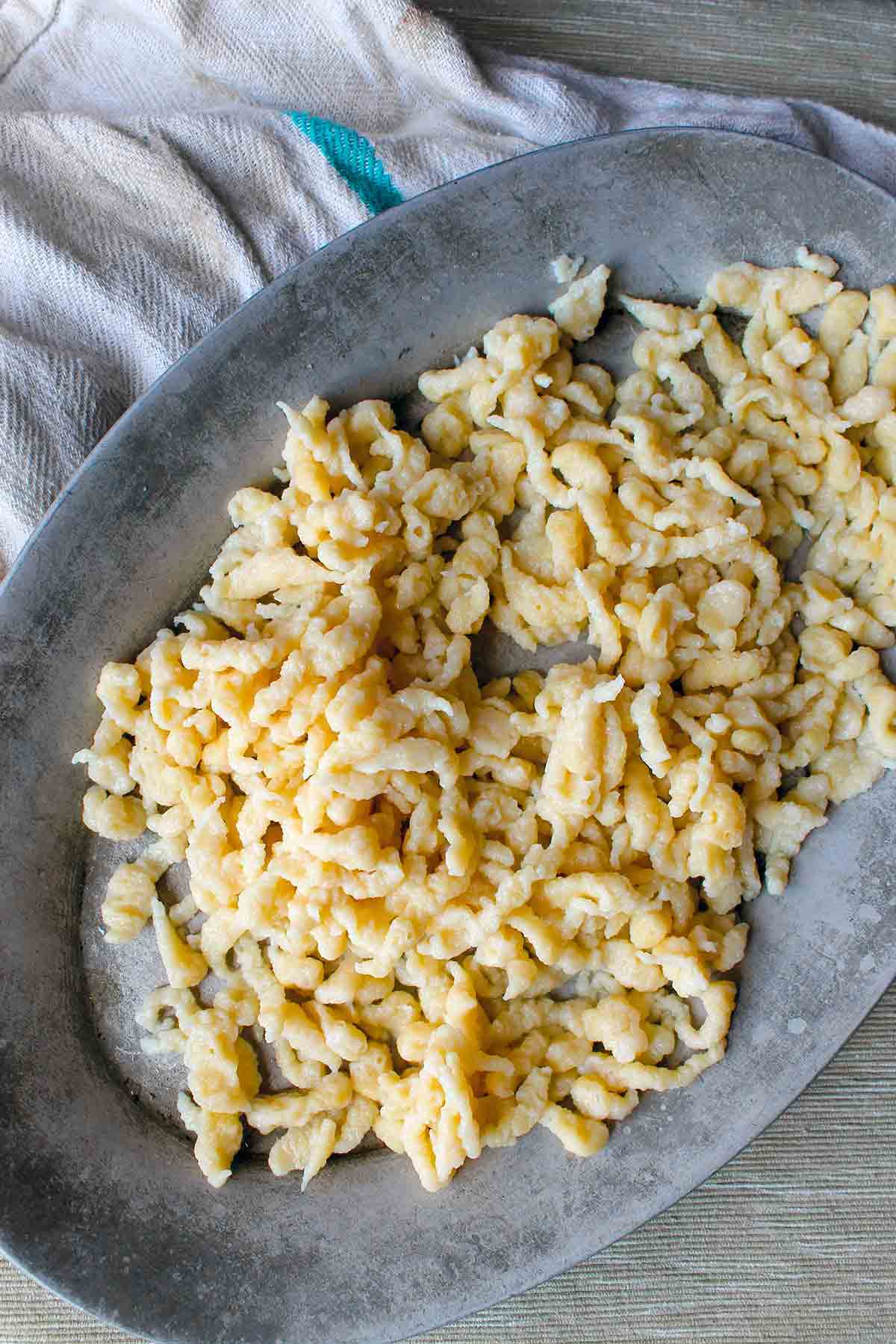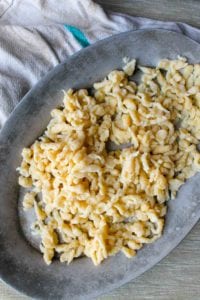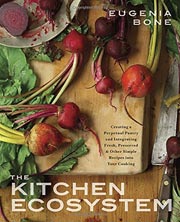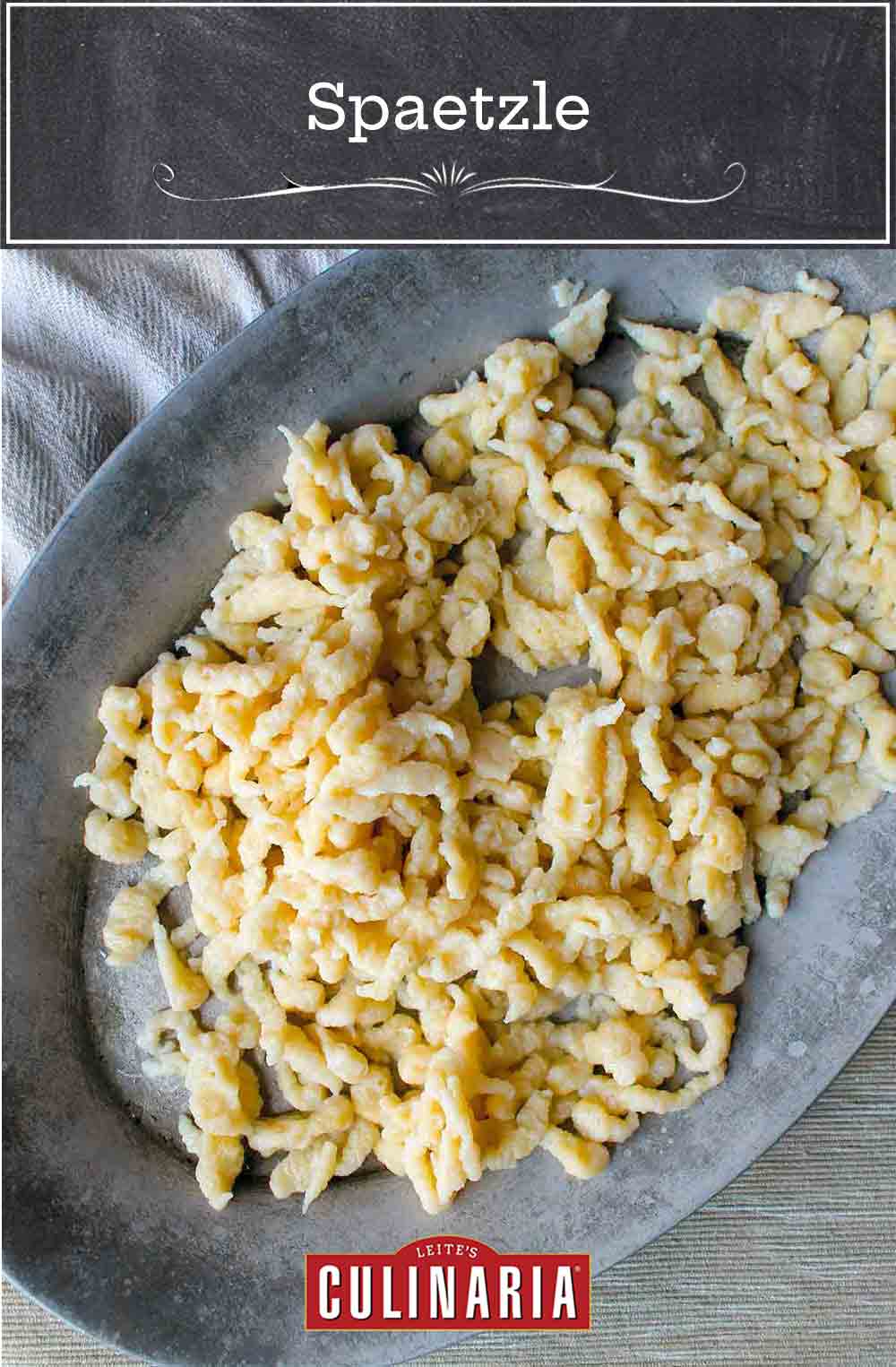
Before we say anything else, let’s just be clear on what spaetzle is and is not. When made properly, homemade spaetzle is a light and pillowy pasta dumpling of sorts that comes together from just flour, eggs, and milk. And it requires no fussy rolling or shaping. Instead, it utilizes a nifty and unfussy technique to shaping the squiggles (spoiler alert: you’ll need a colander). Spaetzle isn’t difficult or expensive to make, although—we’re just going to come right out and say it—it can be a touch tricky to make. Not tricky in a don’t-bother-making-it sorta way. Tricky in a just-be-warned-things-may-get-a-little-messy way. What results is still a worthy, not to mention inexpensive and weeknight-friendly, venture.–Angie Zoobkoff

Homemade Spaetzle
Equipment
- Spaetzle maker or colander (not a sieve)
Ingredients
- 2 cups all-purpose flour
- 3 large eggs, lightly beaten
- 2/3 cup whole milk, plus more as needed
- Pinch sea salt
- Pesto or melted butter or brown butter, for serving
- Freshly ground black pepper
Instructions
- In a bowl, whisk together the flour and eggs and then slowly add the milk, whisking all the while or switching to a dough hook on a stand mixer or a wooden spoon. Add the salt and combine. The batter will most likely be thick and sorta sticky.
- Bring a large pot of salted water to a boil over high heat. Carefully hold a spaetzle maker or colander over the boiling water and dump the batter into it. With a spatula, press the batter through the holes in the maker or colander. This will produce little squiggles of pasta, which will float to the top of the water when they are done, which ought to take a couple minutes. (Some may float to the surface right away, but go ahead and let them gently simmer for at least 1 1/2 minutes.)
☞ TESTER TIP: If you've got someone else at home who you can holler at to come and help you, that's spectacular because this works better if one person holds the maker or colander and the other pours the batter.
- Scoop out the spaetzle with a slotted spoon and place in a bowl.
- Toss with the pesto or butter and season with salt and pepper to taste.

Explore More with AI
Nutrition
Nutrition information is automatically calculated, so should only be used as an approximation.
Recipe Testers’ Reviews
Spaetzle is a staple in my husband’s German family. Since I’d never made it before, I was really interested in trying this recipe. I was cooking for 15 people at a family dinner, so I doubled the recipe. This recipe doubled easily and worked beautifully. My husband’s family loved them, even my mother-in-law.
The consistency of the batter should be like a really thick pancake batter, too thick to pour off a spoon but thin enough to fall off a spoon. Mixing took about 20 minutes, and the cooking took about 40 minutes. I chose to use a spaetzle maker I had been given instead of a colander. I did try one batch in a small colander but found it to be a little cumbersome.
The spaetzle must be cooked in smaller batches so as not to crowd the pot, and the pot should be kept at a slow boil. This keeps them separate, allowing them to be removed from the pot easily when done. Doubling this recipe easily made enough for 15 people and there was even a little left over. Some of the spaetzle are done almost immediately, floating to the surface within 30 seconds of going into the boiling water, but for the most part, it takes a couple of minutes for the all the dumplings to rise to the top. I placed them on a towel-lined baking sheet to absorb any excess water and tossed them with brown butter, salt, and pepper, as is traditional.
Because this is so easy to make that you’ll be making this dish on a regular basis, I would recommend investing the $20 or $30 for a spaetzle maker. It really does make the process go faster.
I love spaetzle. I’m from a Bavarian family and have had it both at home and in Germany. It’s definitely a comfort food. Sprinkle it with a little cheese, and it’s hard to go wrong. This recipe came together very easily and of course uses kitchen staples.
The dough was thick and sticky—getting a smooth dough was not going to happen. I don’t have a special spaetzle maker, so I used my colander. I didn’t think about the fact that it had graduated size holes that made cooking slightly challenging. In the past, my dad made homemade makers by poking uniform holes in the bottom of a plastic milk jug. My colander was awkward to hold, and it was hard to get the thick, sticky dough through. The more I pressed the dough and worked it, the thicker and stickier it got. So after the first batch, I ended up adding about 1/4 cup more milk. This helped just enough to allow the dough to pass through the holes.
The mini dumplings cooked very quickly once in the water. It only took 30 seconds or so. I stopped every couple minutes to scoop. There didn’t seem to be any adverse affect to the consistency by leaving them in for a minute past initial float.
Once I had cooked the entire batch, I browned some butter in my Dutch oven and tossed the spaetzle back in. I seasoned with salt and pepper and served with a bit of grated Romano on top. My family all devoured it!
Tomorrow these will be the “noodle” in my chicken noodle soup. Love that!
I’ve been making spaetzle since the mid ’90s and this recipe is fairly simple. For many years I rolled and punched each one by hand, but thought I’d try the colander method, which is a vast improvement. Place the colander over the water and quickly add the batter; otherwise, you may end up with a huge mess. Do this in batches; don’t dump all your batter in at once or it will crowd the pot, and some of your noodles will overcook.
You may have to rinse the noodles with cool water to keep them from sticking together as you cook the other batches. I made brown butter with sage and put just a slight crisp on the noodles in the butter, as I don’t like to just pour the melted butter over the noodles, but that’s my preference.
I’ve long had a spaetzle “lid” that fits over a pan, but I’d never got around to using it. When this recipe showed up, I decided it was about time that I put it to use. This is an easy spaetzle recipe with great results!
The batter is quick to put together. The result is a very light pasta dumpling that can be used in many ways. I tried using it in a couple different dishes. First, I tossed it with some warm sage-infused olive oil and sprinkled it with grated Parmesan cheese. Second, I tried it with leftover pork tenderloin and the luscious pan juices from the pork. These would be great tossed with pasta sauce, added to soups, even incorporated into a pasta salad. They’d be great browned in a little butter and served as a side instead of potatoes or rice.
I just found my spaetzle maker, so it was a treat to make this recipe. It was difficult to whisk the milk into the flour and eggs; I think a spatula would have worked better.
These were light. We settled for butter, salt, and pepper on the finished spaetzle—a hardship for sure! Next time I would add a little nutmeg, which amps up the flavor.
I could not believe how simple this recipe was to make! I’ve always loved spaetzle, ever since gorging on it almost continuously while traveling through Germany for a week. It’s been popping up on a lot of hip menus lately, which has just fueled my love for the squiggly little noodles.
The dough came together in 5 minutes, and I let it sit for about 30 minutes while I prepped the other ingredients. The dough was incredibly sticky, like glue. I used a large-holed grater to drizzle the dough into the water. From what I’ve seen, a spaetzle maker is just that with a feeder tube on top of it. Smearing the dough over the holes with a spatula did the trick perfectly.
I sautéed it ll with caramelized onions, kale, whole grain mustard, butter, and chicken and it was probably one of the tastiest and easiest meals I’ve made lately. Once everything else was good to go, the only step needed to elevate this to a heavenly dish was to brown them up in plenty of butter and toss with the rest of my accoutrements. All in all, the whole meal probably took about 40 minutes, prep time included. I would log this in my weeknight meals folder and continue to experiment with the endless possibilities for serving spaetzle.
Had I not selfishly eaten more than my share of this recipe, I believe this would have been the perfect amount for 4 people as a side to a main or incorporated into the main dish.
It really helps when you make this recipe to have a spaetzle maker, but it can be done in a colander with fairly large holes. If you’re making these without a maker, then it helps to have another person assisting you when you scrape the dough into the boiling water.
The recipe can be assembled and mixed in about 5 minutes. The batter is fairly hard to mix with a standard whisk once the milk is added, so I would use either a dough whisk or simply a wooden spoon. The batter had the appearance of a thick, lumpy cake batter. The scraping and cooking took about 8 minutes for a total time of about 13 minutes.
Just like when you cook pasta, the only way to know if the spaetzle are done is to taste them. After they were cooked through, I tossed them in a couple of tablespoons of butter and seasoned them with pepper. The water I cooked them in had been thoroughly salted, so no additional salt was needed.














My “dumplings “ were tough . I expected them to be fluffy. WHY?
Patot, it’s possible that your dough was too thick. It should be the consistency of a very thick pancake batter, but not as thick as a traditional bread dough. Also, you want to take care not to overwork the dough which can cause it to be tough. You just want everything to come together.
Sounds wonderful!! Has anyone made this with Gluten Free flour; just asking. Tell us your experience.
Suzi, none of our staff has, but perhaps some of our readers have! Readers? Can anyone help out Suzi?
Use cold water to rinse off batters and Sourdough Starters instead of hot. With hot water you are cooking the batter onto your dish. After a cold rinse, then wash as usual. Also my colander fits perfectly over my stock pot so I just pour the batter and stir with two chopsticks held in one hand. Be quick or you’ll steam the batter in the colander!
Brilliant, Andi. Always greatly appreciate you sharing all your insights, tricks and wisdoms!